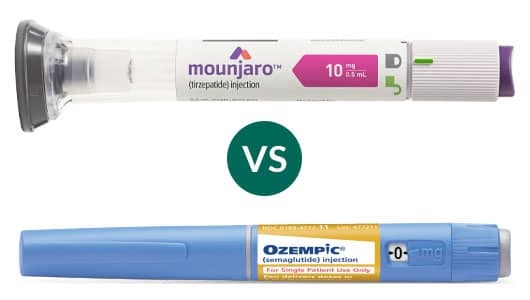Mounjaro and Ozempic are both medicines that help with Type 2 diabetes. They are approved by the FDA and are similar because they belong to the GLP-1 group of drugs. When scientists looked at them in research, they found that Mounjaro worked better than Ozempic in blood sugar control and helping people lose weight. However, Mounjaro costs a bit more and might cause many side effects. Let’s discuss more about it:
- How Mounjaro and Ozempic Help with Diabetes
- Is It Okay to Use Both Together
- Differences Between Mounjaro and Ozempic
- Which Works Better, Mounjaro or Ozempic
- Ozempic vs. Mounjaro for Losing Weight
- How Are the Side Effects of Mounjaro and Ozempic Different
- Recent Safety Concerns
- Mounjaro and Ozempic Interactions
- Price Differences Ozempic vs. Mounjaro
- Should I Choose Mounjaro and Ozempic
How Mounjaro and Ozempic Help with Diabetes
Mounjaro and Ozempic work to control Type 2 diabetes by doing a few important things in the body. They help the body make more insulin when we eat, stop the liver from making too much sugar, and slow down the emptying of our stomachs. These actions make us feel less hungry, eat less, and lower our blood sugar.
Mounjaro also does one more thing to lower blood sugar: it reduces a hormone called glucagon. Glucagon usually raises blood sugar levels and prevents them from going too low. Mounjaro and Ozempic act like a hormone called GLP-1, which helps with digestion and keeping blood sugar in check.
Is It Okay to Use Both Together
No, it’s not a good idea to use Mounjaro and Ozempic together. Doctors don’t suggest taking two GLP-1 drugs at the same time. But you can change from one to the other as they help with Type 2 diabetes and do similar things. Just remember, switching might cause many side effects as your body gets used to the new medicine.
Your doctor will change your dose if you need more or less help with your blood sugar. If neither of these drugs works for you, your doctor will suggest a different medicine.
Differences Between Mounjaro and Ozempic
Mounjaro and Ozempic are both medicines called GLP-1 drugs, but they are not the same. They are made by different companies, Novo Nordisk and Eli Lilly and Company.
The FDA says both of them can help with Type 2 diabetes, but Ozempic can also lower the chance of serious heart problems in people with Type 2 diabetes and heart disease.
Ozempic has something called semaglutide in it, and it comes in different doses like 0.25 mg, 0.5 mg, 1 mg, and 2 mg. Mounjaro has a different thing called tirzepatide in it, and it comes in doses like 7.5 mg, 2.5 mg, 5 mg, 10 mg, 15 mg, and 12.5 mg.
Mounjaro gives these doses using a pen that you can use only once. Ozempic uses pen injectors too, but each pen might have more than one dose inside.
Which Works Better, Mounjaro or Ozempic
Different people react in different ways to medicines, but research has found that Mounjaro is more effective than Ozempic at blood sugar control. In a study called SURPASS-2, Mounjaro lowered A1C levels better than Ozempic.
According to the results of this study published, when taking the 1 mg dose, Ozempic lowered A1C levels by almost 1.86% points. On the other hand, Mounjaro lowered A1C by 2.30, 2.01, and 2.24 for the 5 mg, 10 mg, and 15 mg doses, respectively.
Ozempic vs. Mounjaro for Losing Weight
Mounjaro is better than Ozempic for helping people lose weight, but it’s important to know that neither drug is officially meant for weight loss. People in Mounjaro’s tests lost around 12 to 25 pounds, as shown in Eli Lilly’s research.
In Eli Lilly’s SURMOUNT-4 and SURMOUNT-3 studies, those who took Mounjaro lost about 21.1% of their weight in 12 weeks and a total of 26.6% over 84 weeks.
In Novo Nordisk’s SUSTAIN 7 and SUSTAIN FORTE trials, people who took Ozempic lost about 9.3-14.1 pounds. On average, those taking Ozempic lost approximately 15% of their body weight in 68 weeks, based on research published.
How Are the Side Effects of Mounjaro and Ozempic Different
In general, Mounjaro and Ozempic have similar side effects, but Mounjaro might have more and more serious ones. Mounjaro’s information says it could cause severe stomach problems, but Ozempic’s information doesn’t mention this.
During clinical trials, more people had to stop taking Mounjaro because of stomach issues compared to those taking Ozempic. And in both drugs, taking higher doses led to many side effects.
Mounjaro and Ozempic have important warnings about thyroid C-cell tumors, which can be cancer. The labels of these drugs also mention concerns about pancreatitis, diabetic eye problems, low blood sugar, kidney issues, allergic reactions, and sudden gallbladder problems.
After these drugs were available, some people mentioned having problems called ileus with Mounjaro. Ileus is when the intestine doesn’t squeeze the right way, causing tummy troubles and difficulty passing waste from the body.
Recent Safety Concerns
Lately, there have been worries about the safety of both medicines because some patients had serious stomach problems like gastroparesis, where the stomach doesn’t work properly and it could make them end up in the hospital.
Mounjaro’s information talks about these severe stomach issues and says it shouldn’t be used in people with gastroparesis because it hasn’t been tested on them.
On the other hand, Ozempic’s label doesn’t mention gastroparesis or bad stomach problems. It only says that if someone has stomach issues, they should be watched for possible kidney problems.
One person took both Mounjaro and Ozempic and got very sick with gastroparesis. It was so bad that she had to go to the hospital, and she even filed a lawsuit about it in August 2023.
Mounjaro and Ozempic Interactions
Both Mounjaro and Ozempic can cause similar interactions with other drugs, as mentioned in their instructions. They both say that when taken with certain medicines called sulfonylureas or insulin, there’s a higher risk of having low blood sugar (hypoglycemia).
Patients should talk to their doctors about possibly lowering their insulin or sulfonylurea doses if they are taking either of these drugs.
Mounjaro and Ozempic can also slow down how fast the stomach empties and affect how some pills work. Ozempic’s label didn’t mention any significant problems with how pills are absorbed. But Mounjaro’s instructions recommend using a different type of birth control or adding a barrier method for four weeks after starting treatment and after each dose increase.
Price Differences Ozempic vs. Mounjaro
Mounjaro and Ozempic don’t have a big difference in cost, but Mounjaro is a bit more expensive than Ozempic. On average, Ozempic costs around $1,000 every month in the U.S.
Mounjaro’s price is listed at $1,023.04 for each prescription, as stated by Eli Lilly. Some reports even mention that it could be as high as $1,300.
To help people with the cost, Novo Nordisk and Eli Lilly have some discount programs for these drugs. However, how much you pay out of your pocket depends on your insurance.
Right now, most insurance plans don’t cover the cost of Mounjaro or Ozempic for weight loss because they are not officially approved by the FDA for treating obesity.
Should I Choose Mounjaro and Ozempic
Deciding between Mounjaro and Ozempic depends on what you need for your treatment. Mounjaro is better for losing weight and lowering A1C, but it might have many side effects, especially concerning the stomach.
Ozempic is good at lowering A1C and helping with weight loss. It’s also approved by the FDA to reduce the risk of heart problems for people with heart disease, which is important for those with Type 2 diabetes because they already have a higher risk of heart issues.
Before deciding, it’s essential to talk to your healthcare provider about the advantages and disadvantages of each medicine. If the first drug you try doesn’t work well for you, it’s possible to switch to the other one.
Read More: Ozempic vs. Mounjaro- What Is Crank Drug?
- What Are Blues Drugs?
- Top Rehab Centers in the USA; Best Rehab Near Me!
- What Are Whippets Drugs? Is it safe to consume?
- TCL 341 Pill | Uses, Side Effects, and More
- How To Get High Without Drugs?
- MARIJUANA ABUSE: WHAT IS GREENING OUT MEAN?
- Cymbalta Withdrawal: Side Effects & Symptoms
- How long does Suboxone withdrawal last?
- Suboxone Strips: Effective and Convenient Treatment for Opioid Dependency

I am a passionate technology and business enthusiast, constantly exploring the intersection where innovation meets entrepreneurship. With a keen eye for emerging trends and a deep understanding of market dynamics, I provide insightful analysis and commentary on the latest advancements shaping the tech industry.
